-
Content Count
328 -
Joined
-
Last visited
Posts posted by rawcustom
-
-
6 hours ago, LyndHoll said:What are you using to cut your stingray? That stuff is killer to cut! Any suggestions?
I used a headknife and a trim knife. I'm a knifemaker so I make my own leatherworking knives which allows me to use far superior steel than what is available commercially. I believe I used my head knife in a roll cut manner for most of this project.
-
-
There are several knifemakers on this forum, myself included that can make you a headknife. However, it sounds like you are just wanting the steel and plan to do the rest yourself. That is likely to limit your options.
This is a common request from those looking to save money, or those who have something special for a handle in their possession. If it is the latter, many knifemakers will work with you and allow you to supply handle material if it is appropriate to use on a build. If it is the former, than you may have to look a little harder or reconsider your price point. A knifemaker is a craftsman, and I don't know of many good craftsman that are content producing/selling unfinished goods.
-
On 11/6/2016 at 10:14 AM, mustangman2 said:very nice and its nice to see another Montana person on here.
Thanks, where in MT are you?
-
-
On 9/17/2016 at 7:33 PM, silverbullet said:Glad to see you used the copper rivet , I've had many of the two piece pretty ones let go. Nice job on the knife. Like the style itself. I've made a few so I know how much time you put into it.
Thanks. I too lack faith in the double cap rivet after having multiple fails many years ago. Granted I attribute part of those reasons for not using proper rivet setters, but it shook my faith in them. I have pretty much switched entirely to tubular rivets, but the copper burr rivet has it's place for looks and for adding a wider clamp into the leather. I used it on this sheath for both reasons, looks good, and provides a friction lock against the finger guard when sheathed.
-
I'm too busy at work for a full response, but several points here are straying into opinion and are demonstrably false. The theory of "better back then steels", the theory that there aren't steels made for cutting/knife industries today, and lastly the notion of forged steel producing a better end steel product.
If you can blame a decrease on steel quality found in common tools today it's a matter of economics more than steel having some forgotten lost art from how it was produced a 100 years ago. The leather industry is a dead industry. That is why there is little selection of quality and most tools available are cheaply made overseas and people are surprised that they don't handle, cut, or wear like the tools of old.
Remember steel is only part of your product. Heat treat, grind geometry and ergonomics will all play into your desirability of a knife. If a rifle shoots a ragged hole at 200 yds but weighs 20lbs, it won't be your go to mountain rifle.
-
On 6/2/2016 at 11:36 AM, rawcustom said:So a steel with all the right ingredients means little if it were processed crudely and/or heat treated incorrectly. Conversely a steel with substandard ingredients mixed exacting and heat treated correctly will outperform a steel that had better ingredients (potential) but failed on realization.
Well you seemed to arrive at the same point I laid out in the opening post, however your assumption that the alloy is of no importance would be just as wrong as saying the heat treatment is of no importance.
-
Well after much consideration I’ve decided to reply. But first to redress some of the initial comments and clarify a couple of points.
Knife Grade steel, as pointed out by Art is not a universally defined term, so has no general accepted criteria or meaning. This is a term I use (my opinion) to define a steel suitable for knife making, typically being content of ~0.7% carbon or more along with usually 2 or more alloy components. There are exceptions, cobalt steel being one of them, but jumping to flint knapped obsidian is beyond a stretch, after all the term uses steel not glass, but thanks for playing.
Alloyed steel versus simple steel. A simple steel is carbon + iron, although that’s nearly impossible to find as even the most basic steels incorporate a few extra alloys for added benefits. Alloyed steel or what I refer to as high-alloyed steel is yet another subjective term that I use. To me I define a high-alloyed knife steel as ~0.7% carbon or greater along with ~4 or more alloy elements, or any high percent 1-3 alloys, and I would define this roughly around 5%+.
Maybe that is a bit confusing but a couple takeaways. I use and define these terms to talk about steel in knifemaking since the common terms, stainless vs. high-carbon, are meaningless (see first post). Second, an alloyed steel or what I would refer to as a high-alloyed steel does not mean stainless. It can be stainless, but there are many, many that are not.
Now the real sticking part with folks is that I can say that the performance aspect of a knife (or really steel in general) can be improved with alloys. What I didn’t say is that these changes are preferred or desired as that is a matter of personal preference. You can argue that a pocket knife should be stainless, or that chisels of SV-35 would be too hard to sharpen (personal opinions on use, not relevant to the discussion), but what you can’t argue is that a simple steel such as 1080 can hold an edge as long SV-35, or that 1080 can take the toughness abuse of 5160 or 52100 or that 1095 will retain a red temper as well as M2. But remember, just because you can increase a steels attributes in what I consider the aspects important to a knife (edge retention, toughness, durability) does not make the knife “better” for a given user or task, again personal preference. Increasing any one of the attributes often comes as a trade-off, such as better edge retention will be harder to sharpen. Just as importantly the steel alone will not dictate the user’s satisfaction of the knife. Steel and heat treatment (hardness), grind geometry, and fit and functionality for the desired task, are all vital to overall satisfaction of use. So just because a steel can be produced to have an increase in a given attribute does not mean an increase in desirability by the user since preferences vary widely and wildly and they always do.
Again I will state this thread has nothing to do with “what steel is best” because that is really nothing more than “what steel do I like best”. If you read my original post I am attempting to give the average consumer some information about steel used in knifemaking that goes beyond the simplistic, inaccurate notion of a 2 categorical system of “stainless” vs “high-carbon”. It also has nothing to do with the benefits of a custom knife being “custom”, or being able to have someone make your drawing into a knife (personal opinions about custom knives, not relevant to the discussion). Lastly it involves marketing only in the sense that hopefully those of you that read this will have a better idea to see through the BS, and look for what matters to you.
Now if you want to argue for your favorite steel, by all means start a thread and get to it. That is a pointless debate and not one I will engage in. I do regret playing along to start with, but that simply isn’t what this thread is about. If you want to add some helpful information (maybe someone else can try to explain “surgical stainless”) or would like to clarify some common misleading information to help demystify choosing steels or good resources on the matter, than please join in.
So what was this post all about? This is a forum for leatherworkers, many of which are getting started or looking to improve their game. There is a wealth of knowledge being shared on every type of leather, treatment of leather and working of leather including the knives to cut leather. For those who are looking to buy or build a knife for cutting leather, there simply isn’t much information out there aside from a few known brand names or makers. Lots of assumptions and lots of the “high-carbon” cries. As I’ve tried to point out, there is much more to a steel than what most assume. Those who read this in their search will hopefully use this information to end up making a better choice as to what would be more suitable for their needs, or at least learn enough to talk to a maker, or determine what steel they have before trying to make it into a knife. You should consider what attributes are important to you, or what you are trying to accomplish and start there. Maybe to some having a knife that you can hammer through a 2x4 makes a lot of sense. Personally I would rather use an axe or a saw, but if that’s your bag you should be looking into spring steels and differential tempered steels, all things that will require you look deeper than “high-carbon”, or even more meaningless “carbon”.
So don’t buy a knife because it’s “high-carbon” or because it’s “stainless” (unless you buy cars because they are “wheeled” or “motorized”). You put time into finding the right leather, the right dye, the right conditioner, so don’t expect steel to be any different.
-
Ha! That's number 2 on my list and seeing how thus one is going I doubt I'll kick that hornet nest!
-
If anyone would like to quote me where I stated stainless is better than or where high carbon is better than, please do so. Otherwise I ask people don't try to argue that as I know like Art that argument has no end.
Also steel is iron+carbon.
Alloy steel is iron+carbon+other elements
-
Back to arguing for stainless vs nonstainless. I suppose I could keep up this pointless back and forth. Art you are following, please delete this thread. I feel Martyn has won the disinformation campaign and this will only serve to confuse people more than help. The High-carbon vs Stainless idiocracy continues!
-
Martyn, you really need to stop posting as you clearly are trying to draw a stainless be nonstainless comparison that I have stated in near every reply is not the purpose of this thread. You argue against alloy steel by citing an alloy steel so I see no validity in continuing a discussion trying to educate you beyond stainless and nonstainless. At thus point your simply diluting the thread with nonsensical replies. If you really wish to continue than I suggest we PM. Otherwise you only help confuse those wanting to learn something. I'm sorry I can be more patient but you continue to argue against the same side you are cheering. And the video is cute but pointless. All it proves is you can break a knife with a hammer and spoiler alert, you can break all knives with a hammer.
-
Just a recap, before too many feathers get ruffled. I haven't stated a single steel is the best for all purposes because that's opinion. I have stated the difference between some common marketing words out there, and will state again that yes, an alloy steel will out perform a simple steel except price, and I guess I should add work ability. I'm not saying stainless is best, or high-carbon is best. I am saying that a properly alloyed steel is better than not. If you want edge retention look for vanadium, if you want shock resistance look for lower chromium and molybdenum, if you want corrosion resistance than chromium or nitrogen steel. Some alloyed steels don't need much alloy, 0.5% vanadium makes a difference, but they are still better knife blades than those without.
-
I'm not sure why you keep jumping back to chromium content. If you read my statement I say that an alloyed steel is better in knife making than a simple (carbon and iron only) steel.
I work with 1080 and I like it for certain applications. Again, not everything needs to be stainless or high-alloy, but it is far from being a tough steel. If were going to talk tough steel I would start with CPM-3V. If you just want to talk toughness in general I would go with S7.
Also 1080 used in knifemakig is not a true simple steel. It contains manganese, sulfur, phosphorous, and sometimes vanadium.
-
15 minutes ago, Martyn said:means they are often used in higher impact and bend/stress activities, which makes carbon a more suitable choice
Long held beliefs.
You are arguing for "carbon" steel being better at impact and stress than an alloyed steel. Please list which "carbon" steel this is.
I would also like to know which "carbon" critical structure steel is you are referring to that has higher strength and toughness?
-
7 minutes ago, Martyn said:I would disagree with the toughness part.
I think you are confusing strength for toughness. But again you would be wrong. Toughness as in impact strength can be greatly increased with alloy elements beyond iron and carbon, strength as well. Chromium is just one of many alloys, that can be added to a steel.
Edge retention is sharpening resistance. I guess you could argue the point of a good knife sharpens quick/ dulls quick, and that we'll just have to disagree. Well carbon steel doesn't really specify anything. Remember I quoted simple carbon steel which is just iron and carbon. Price point and tradition are strong followings. Many can assume a steel works "good enough" for it's intended purpose that they don't feel a need to upgrade. They have been making carpenter tools for the last few thousand years. Modern high alloy powder metallurgy steels haven't been on the scene more than about the last 50. Also Chromium is more than cosmetic, and corrosion resistance is an important attribute to many applications of steel. And check the components of stress critical, again they aren't simple carbon, and again I wasn't commenting on strength, as that implies structural properties more common to bridges than knives.
-
You are right Art "knife steel" is not an official term, much like "sniper rifle" doesn't imply anything other than a rifle a sniper has used. In my use of it I am referring to a steel intended for knife use that is generally a high carbon (0.7%+) that has a few extra alloys, the most common is chromium, but often include molybdenum, vanadium, tungsten, etc. You are also correct that application has a lot to do with choice of steel selection, it also has a lot to with HRc settings as much as the chosen steel itself. Depending on the knife I could use the same alloy at 58rc or 62rc. Some alloys can handle higher HRc better than others. Some have to have HRc considered with edge geometry to work, but alas the position of this post is to educate people beyond stainless and high-carbon advertising common to the craft.
So to avoid confusion I'm not inventing a knife steel by using the term, I'm just using it to better classify steels that are appropriate for knife making since the terms stainless and high-carbon have very little reflection on a steel suitability for knifemaking.
Also you're proving my point with the Osborne 1065 steel. It's a simple steel that cheap and easy to work with and get a good heat treat. This means consistency, adequate performance, and lower cost.
-
Before I begin I'll give a brief background of myself. I've been a knifemaker practically all of my life, and have had the opportunity to work with and talk with some of the bigger names over the years. I have made knives, tested knives, sharpened knives, read about knives, and done enough studies and research in metallurgy that I should have probably declared that as my major back in college. That being said I find plenty of misconceptions strewn about for the average consumer who is looking to purchase a knife. Some ideas, right or wrong, are held onto tight and I realize some people can get worked up to hear something contrary to their held ideas. So if you can't read a view contrary to your own without getting upset, than please don't proceed reading. Just consider that I've done my homework and have born out theory through experience for some time on this.
Since this topic could go on for an extreme length I will limit this particular discussion to one of my favorite misconstrued topics: Stainless vs High Carbon steel
To start with, the term “stainless” only defines chromium content in steel, with a steel containing 13-14% or more chromium being considered “stainless”. By this same criteria we have everything with less chromium considered “non-stainless”.
The term “high-carbon” references a steel that has 0.3% or more carbon content. Realize that most any suitable high-carbon knife steel will be at least 0.8% carbon. So you can use “high-carbon” steel that is in fact totally unsuited for knife making, a great example is the HC stamped RR spike.
So a steel can be high-carbon stainless, or high-carbon non-stainless, or low-carbon stainless, or low-carbon non-stainless. The most important fact is that by these labels alone you cannot determine a knife’s performance.
Think of it this way, the ingredients in the steel is sort of like putting in your ingredients for some breakfast muffins. The purity of your ingredients, the ratio of your ingredient, and your consistency in always adding the same amount each time are all critical to your end result. However, your ingredients are what I call the potential, not the realization. The next step is how the ingredients are mixed, and lastly how they are cooked. Steel is very similar that the mixing and forming of the alloy is crucial to the grain and performance, and the heat treat (cooking) must be exact to complete the realization of the added ingredients and mixing. So a steel with all the right ingredients means little if it were processed crudely and/or heat treated incorrectly. Conversely a steel with substandard ingredients mixed exacting and heat treated correctly will outperform a steel that had better ingredients (potential) but failed on realization.
So why all the trash talk on “stainless” you may ask? I think this traces back to the fact that many, many cheap knives are using substandard stainless steel, not a knife grade steel. They also put little investment into the heat treatment and may be dealing with a foundry that runs very loose specs on its formulation, and is likely using older mixing and casting methods. So they essentially start with poor ingredients, put little effort into mixing, and are trying to flash cook them or may skip that step entirely. They still can label it “stainless” and the uneducated consumer thinks stainless = knife steel. Stainless knife grade steels require a very drawn-out, multi-step heat treatment, that must be exacting for success.
So why all the hype over “high-carbon” you may ask? Well for starters most people marketing high-carbon are dealing with simple steels. Remember steel is only iron + carbon. More alloys can be added of course, but that is all it takes to be a steel, and is commonly called a simple steel. High carbon simple steel is much cheaper than it’s stainless or alloyed counterpart. It also can be produced as decent quality with less technology than an alloyed/stainless steel. Lastly, it has a much simplified and easy heat treatment process compared to stainless. So with limited ingredients, they mix with less effort, and the cooking process is more like a toaster, very simple and fool proof.
In short, the high-carbon simple steels are much easier to achieve realization from than a high-carbon stainless steel, or a high-carbon high-alloyed steel. This is why you will find more simple steel knives that are effective even at low price points than you will with stainless or alloyed knives. However, they are no match in performance in any respect to a properly alloyed or stainless high-carbon knife steel with an appropriate heat treat. They can be out-performed in edge retention, toughness, corrosion resistance, you name it, except price.
Anyway I hope this is useful for those wishing to learn more. I could go on and on and on, so if the response is positive maybe I will continue with my second favorite myth out there.
-
The owner is member on here and a great guy to deal with. I have a drill press burnisher and use it all the time. I also have one of his mauls and absolutely love it. Both are top notch in quality of fit and finish, and function beautifully. They are also extremely reasonable on price. I tend to make a lot of my own tools, and I can say that these would have cost me more in $ and a healthy dose of time for me to try to make.
-
53 minutes ago, Frederiek said:Nice! Can we see a pic from the other side?
Sorry, didn't take any of the backside and this knife is already shipped. I'll try to get a picture of the back of the next one, although for my pouch style sheaths they're plain and simple.
-
11 hours ago, Kulafarmer said:Nice,,,
what sort of steel for the knife?
M390
-
Thanks. It was a sequential dye starting with red, than diluted dark brown, than antique black, than dark brown highlight, than sealed.
-
Nice holsters Rohn! You have far more patience than me to stamp those weaves out so crisp and even. Well done.

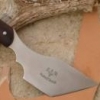
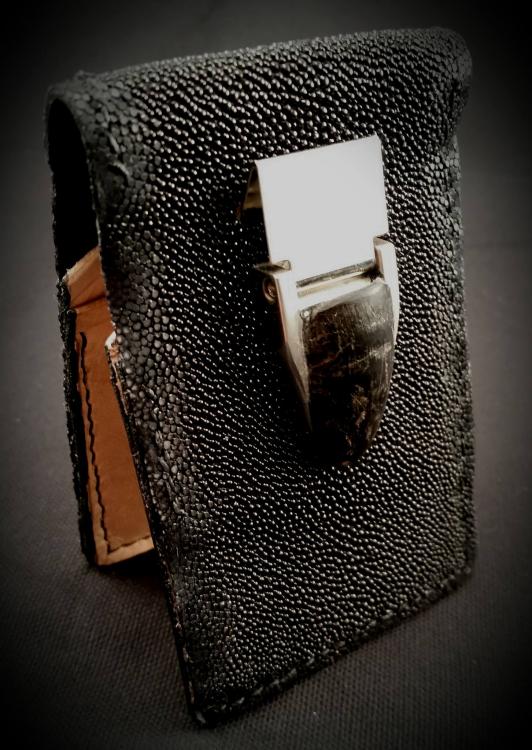
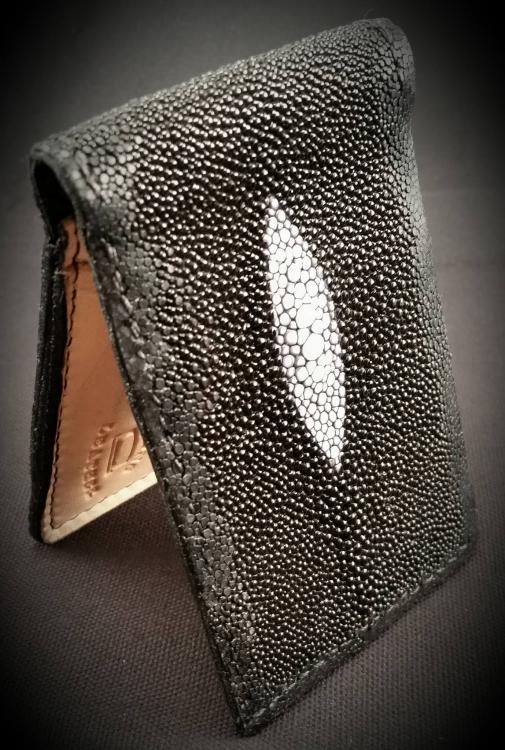
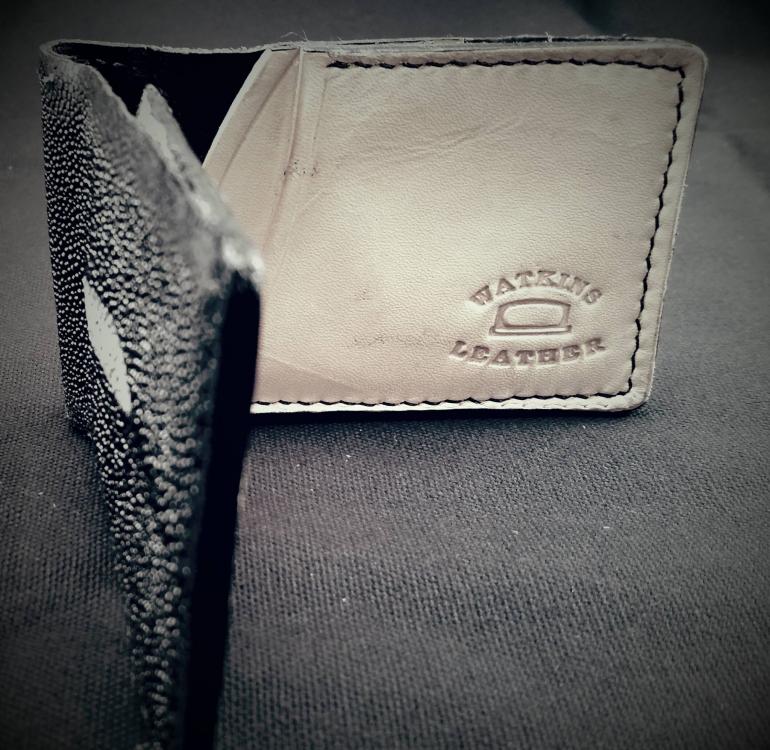
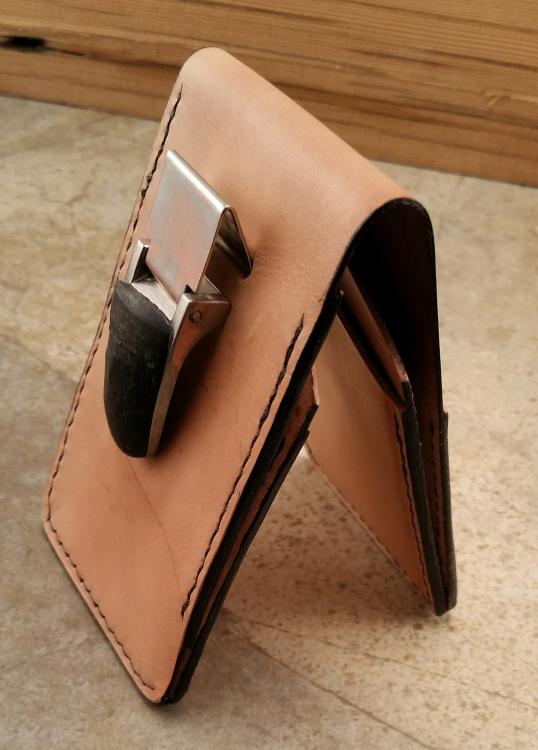
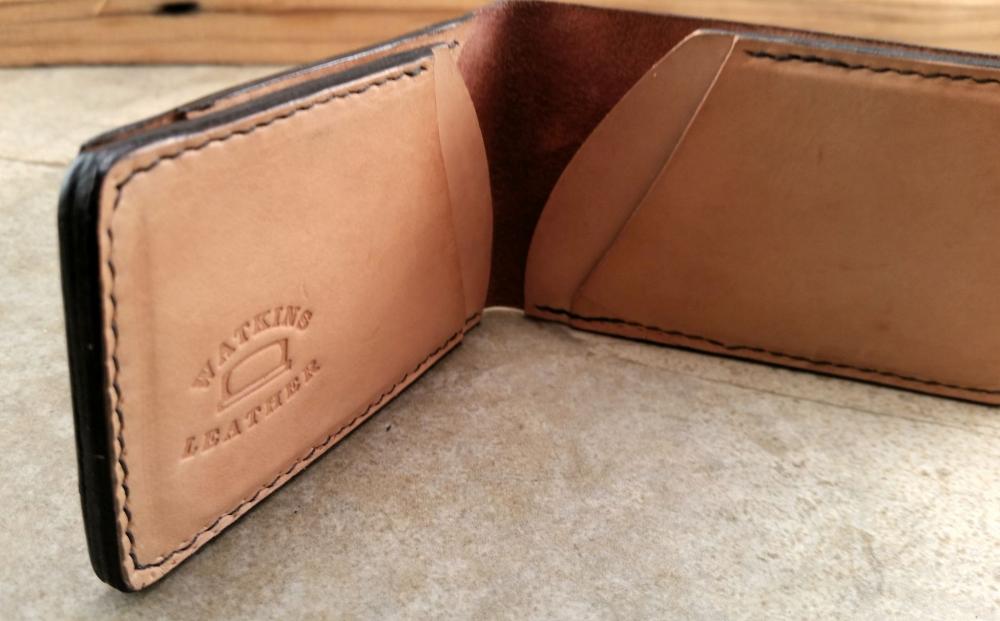

What product for this?
in How Do I Do That?
Posted · Report reply
I've noticed this colorful type of antique paste but not sure what it is? Anyone have ideas on what to use?
I mix my antique with tankote so I suppose any shoe polish would work, but maybe this is a colorful product.